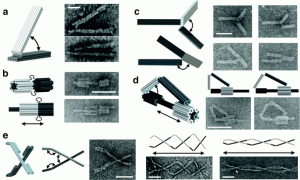DNA origami is an emerging field of nanotechnology that exploits the unique base-pairing capabilities of the DNA bases to produce complex and mechanically stiff self-assembled nanoscale geometries. Recently, DNA origami has found uses in applications such as single molecule sensing, drug delivery and templating molecular components.
This review, by researchers from Ohio State University, sets out to explore the mechanical nature of DNA nanostructures in order to understand how these structures will respond to physical interactions. The review covers three major areas of progress, including measuring and designing mechanical properties of DNA nanostructures, designing complex nanostructures based on imposed mechanical stresses and, finally, designing and controlling structurally dynamic nanostructures.
For researchers interested in the future possibilities of DNA origami, this review should provide an insightful first stop for discussing the mechanical design of DNA nanostructures.
Mechanical design of DNA nanostructures
Carlos E. Castro, Hai-Jun Su, Alexander E. Marras, Lifeng Zhou and Joshua Johnson
Nanoscale, 2015, Advance Article. DOI: 10.1039/C4NR07153K
Dr Lee Barrett is a guest web writer for the Nanoscale blog. Lee is currently a postdoctoral researcher in the Centre for Molecular Nanometrology at the University of Strathclyde. His research is currently focused on the development of nanoparticle-based sensors and surface enhanced Raman scattering (SERS). Follow him on twitter: @L_Bargie











